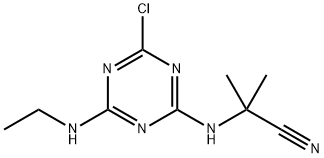시아나진 C화학적 특성, 용도, 생산
화학적 성질
Cyanazine is an off-white to tan crystalline
solid. Molecular
. Hazard identification (based on NFPA-704 M
Rating System): Health 2, flammability 1, reactivity 0.
Soluble in water. Physical properties may be altered by car-
rier solvents used in commercial formulations.
용도
Selective pre-emergence herbicide.
일반 설명
Colorless crystals. Non corrosive when dry. Used as a selective systemic herbicide.
공기와 물의 반응
Stable at pHs between 5.0 and 9.0, but is hydrolyzed by strong acids and bases.
반응 프로필
A triazine derivative.
위험도
Very toxic.
농업용
Herbicide: On August 2, 1995, the U.S. EPA announced a voluntary phase-out of the use of cyanazine. On January 6,
2000, the U.S. EPA announced the cancellation of all cyanazine registrations. It had been A U.S. EPA restricted Use
Pesticide (RUP) because of its teratogenicity and because it
has been found in groundwater. Not approved for use in EU
countries. Cyanazine is used as a pre-and post-emergent
herbicide to control annual grasses and broadleaf weeds. It
is used mostly on corn, some on cotton, and less than 1%
on grain sorghum and wheat fallow. The compound is formulated as a wettable powder, a flowable suspension, or as
granules. In California, major usages are on cotton, corn
and corn for forage, almonds, and uncultivated agricultural
areas. In 1995, cyanazine was the fourth most widely used
synthetic pesticide in the U.S. Cyanazine, atrazine, and simazine are collectively referred to as the triazines and may
be alternatively used for each other on corn and in some
other situations.
상품명
BLADEX®[C]; BLADEX® 80WP[C];
BULLET®; CYCLE®; CY-PRO®[C]; CYNEX®
41[C]; DW 3418®; EXTRAZINE®[C]; FORTROL®;
MATCH®; PAYZE®; SD 15418®; WL 19805®
잠재적 노출
A potential danger to those involved
in the manufacture, formulation, and application of this her-
bicide used for preemergence or postemergence weed con-
trol in field corn.
Carcinogenicity
No increase in tumor incidence
was noted in rats fed up to 50 ppm of cyanazine for 2 years.
The same was true for mice given up to 1000 ppm in their
diets for 2 years.
환경귀착
Soil. In sandy loam soils (foc = 0.01), the half-life is 12–15 days. However, in silt loam
(foc = 0.028) and clay loam (foc = 0.03) soils, the reported half-life is 20–25 days (Humburg
et al., 1989). The half-life of cyanazine is longer in alkaline soils (pH >7.5) than in acidic
soils (pH <5.5) (Humburg et al., 1989)
Groundwater. According to the U.S. EPA (1986) cyanazine has a high potential to
leach to groundwater. Cyanazine amide was identified as a metabolite in groundwater in
corn fields (Muir and Baker, 1976)
Plant. In plants, cyanazine is degraded by elimination of the ethyl group, hydration
of the cyano group and the removal and replacement of the chlorine atom by a hydroxyl
group (Humburg et al., 1989).
Chemical/Physical. In laboratory tests, the nitrile group was hydrolyzed to the corresponding carboxylic acid. The rate of hydrolysis is faster under higher temperatures and
low pHs (Grayson, 1980). The chlorine atom may be replaced by a hydroxyl group forming
2((4-hydroxy-6-(ethylamino)-1,3,5-triazin-2-yl)amino)-2-methylpropanenitrile (Hartley
and Kidd, 1987)
운송 방법
UN2763 Triazine pesticides, solid, toxic, Hazard
Class: 6.1; Labels: 6.1-Poisonous materials. UN3439
Nitriles, solid, toxic, n.o.s., Hazard Class: 6.1; Labels: 6.1-
Poisonous materials, Technical Name Required.
비 호환성
Cyanazine decomposes in heat producing
very toxic fumes and gases of hydrogen cyanide, hydrogen
chloride; ethyl chloride; ammonia; acetone; and ethylene.
Nitriles may polymerize in the presence of metals and some
metal compounds. They are incompatible with acids; mixing
nitriles with strong oxidizing acids can lead to extremely
violent reactions. Nitriles are generally incompatible with
other oxidizing agents such as peroxides and epoxides. The
combination of bases and nitriles can produce hydrogen cya-
nide. Nitriles are hydrolyzed in both aqueous acid and base
to give carboxylic acids (or salts of carboxylic acids). These
reactions generate heat. Peroxides convert nitriles to amides.
Nitriles can react vigorously with reducing agents.
Acetonitrile and propionitrile are Soluble in water, but
nitriles higher than propionitrile have low aqueous solubility.
They are also insoluble in aqueous acids
.Attacksmetals
in the presence of heat and moisture.
폐기물 처리
Dissolve or mix the material
with a combustible solvent and burn in a chemical incinera-
tor equipped with an afterburner and scrubber. All federal,
state, and local environmental regulations must be
observed. In accordance with 40CFR165, follow recom-
mendations for the disposal of pesticides and pesticide containers. Must be disposed properly by following pack-
age label directions or by contacting your local or federal
environmental control agency, or by contacting your
regional EPA office.
시아나진 준비 용품 및 원자재
원자재
준비 용품








